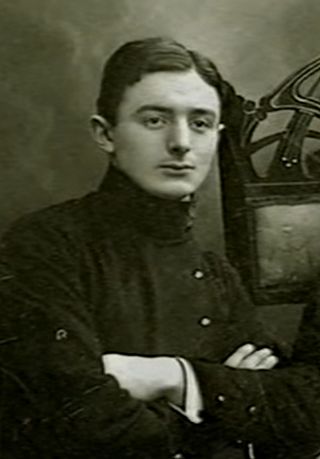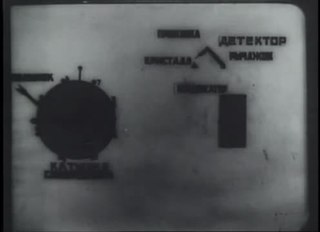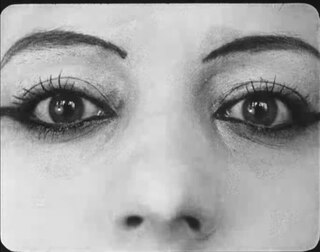
A documentary film is a non-fictional motion picture intended to "document reality, primarily for instruction, education or maintaining a historical record". Bill Nichols has characterized the documentary in terms of "a filmmaking practice, a cinematic tradition, and mode of audience reception [that remains] a practice without clear boundaries".

Dziga Vertov was a Soviet pioneer documentary film and newsreel director, as well as a cinema theorist. His filming practices and theories influenced the cinéma vérité style of documentary movie-making and the Dziga Vertov Group, a radical film-making cooperative which was active from 1968 to 1972. He was a member of the Kinoks collective, with Elizaveta Svilova and Mikhail Kaufman.

Man with a Movie Camera is an experimental 1929 Soviet silent documentary film, directed by Dziga Vertov, filmed by his brother Mikhail Kaufman, and edited by Vertov's wife Yelizaveta Svilova. Kaufman also appears as the eponymous Man of the film.

Kino-Pravda was a series of 23 newsreels by Dziga Vertov, Elizaveta Svilova, and Mikhail Kaufman launched in June 1922. Vertov referred to the twenty-three issues of Kino-Pravda as the first work by him where his future cinematic methods can be observed.
Cinéma vérité is a style of documentary filmmaking developed by Edgar Morin and Jean Rouch, inspired by Dziga Vertov's theory about Kino-Pravda. It combines improvisation with use of the camera to unveil truth or highlight subjects hidden behind reality. It is sometimes called observational cinema, if understood as pure direct cinema: mainly without a narrator's voice-over. There are subtle, yet important, differences between terms expressing similar concepts. Direct cinema is largely concerned with the recording of events in which the subject and audience become unaware of the camera's presence: operating within what Bill Nichols, an American historian and theoretician of documentary film, calls the "observational mode", a fly on the wall. Many therefore see a paradox in drawing attention away from the presence of the camera and simultaneously interfering in the reality it registers when attempting to discover a cinematic truth.

Experimental film or avant-garde cinema is a mode of filmmaking that rigorously re-evaluates cinematic conventions and explores non-narrative forms or alternatives to traditional narratives or methods of working. Many experimental films, particularly early ones, relate to arts in other disciplines: painting, dance, literature and poetry, or arise from research and development of new technical resources.
Narrative film, fictional film or fiction film is a motion picture that tells a fictional or fictionalized story, event or narrative. Commercial narrative films with running times of over an hour are often referred to as feature films, or feature-length films. The earliest narrative films, around the turn of the 20th century, were essentially filmed stage plays and for the first three or four decades these commercial productions drew heavily upon the centuries-old theatrical tradition.

In filmmaking and photography, the Dutch angle, also known as Dutch tilt, canted angle, or oblique angle, is a type of camera shot that involves setting the camera at an angle so that the shot is composed with vertical lines at an angle to the side of the frame, or so that the horizon line of the shot is not parallel with the bottom of the frame. This produces a viewpoint akin to tilting one's head to the side. In cinematography, the Dutch angle is one of many cinematic techniques often used to portray psychological uneasiness or tension in the subject being filmed. The Dutch angle is strongly associated with German expressionist cinema, which employed it extensively.

Man with a Movie Camera is a 2003 soundtrack album by The Cinematic Orchestra, released on 26 May 2003 on Ninja Tune. The album contains re-workings and thematic reprises of some of the music from the band's previous album, 2002's Every Day, including the track "Man with a Movie Camera" and an instrumental version of "All Things to All Men" entitled "All Things".

The Gleaners and I is a 2000 French documentary film by Agnès Varda that features various kinds of gleaning. It screened out of competition at the 2000 Cannes Film Festival, and later went on to win awards around the world. In a 2014 Sight & Sound poll, film critics voted The Gleaners and I the eighth best documentary film of all time. In 2016, the film appeared at No. 99 on BBC's list of the 100 greatest films of the 21st century. The film was included for the first time in 2022 on the critics' poll of Sight and Sound's list of the greatest films of all time, at number 67.
The following outline is provided as an overview of and topical guide to film:

Soviet montage theory is an approach to understanding and creating cinema that relies heavily upon editing. It is the principal contribution of Soviet film theorists to global cinema, and brought formalism to bear on filmmaking.
Lullaby is a 1937 Soviet documentary film directed by Dziga Vertov. The film was shot to commemorate the 20th anniversary of October Revolution.
One of the principal features defining traditional cinema is a fixed and linear narrative structure. In Database Cinema however, the story develops by selecting scenes from a given collection like a computer game in which a player performs certain acts and thereby selects scenes and creating a narrative.
Documentary practice is the process of creating documentary projects. It refers to what people do with media devices, content, form, and production strategies in order to address the creative, ethical, and conceptual problems and choices that arise as they make documentary films or other similar presentations based on fact or reality. Colleges and universities offer courses and programs in documentary practice.

Rain is a 1929 Dutch short documentary film directed by Mannus Franken and Joris Ivens. It premiered on 14 December 1929, in the Amsterdam Filmliga's theater, De Uitkijk.

Ethnocinema, from Jean Rouch’s cine-ethnography and ethno-fictions, is an emerging practice of intercultural filmmaking being defined and extended by Melbourne, Australia-based writer and arts educator, Anne Harris, and others. Originally derived from the discipline of anthropology, ethnocinema is one form of ethnographic filmmaking that prioritises mutuality, collaboration and social change. The practice's ethos claims that the role of anthropologists, and other cultural, media and educational researchers, must adapt to changing communities, transnational identities and new notions of representation for the 21st century.

Moi, un noir is a 1958 French ethnofiction film directed by Jean Rouch. The film is set in Abidjan, Ivory Coast.

Enthusiasm: The Symphony of Donbas, also referred to as Donbas Symphony or The Symphony of the Donbas Basin, is a 1931 sound film directed by Soviet filmmaker Dziga Vertov. The film was the director's first sound film and also the first of the Soviet production company Ukrainfilm. The film's score is considered experimental and avant-garde because of its incorporation of factory, industrial, and other machine sounds; human speech plays only a small role in the film's sounds.

Kino-Eye is a film technique developed in Soviet Union by Dziga Vertov. It was also the name of the movement and group that was defined by this technique. Kino-Eye was Vertov's means of capturing what he believed to be "inaccessible to the human eye"; that is, Kino-Eye films would not attempt to imitate how the human eye saw things. Rather, by assembling film fragments and editing them together in a form of montage, Kino-Eye hoped to activate a new type of perception by creating "a new filmic, i.e., media shaped, reality and a message or an illusion of a message - a semantic field." Distinct from narrative entertainment cinema forms or otherwise "acted" films, Kino-Eye sought to capture "life unawares" and edit it together in such a way that it would form a new, previously unseen truth.













